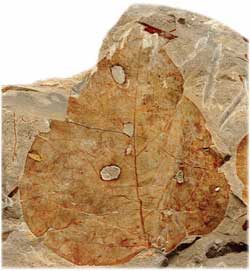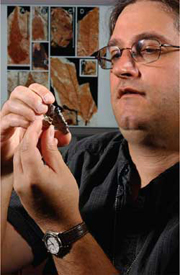Palmettos in Pennsylvania? Magnolias in Minnesota? The migration of subtropical plants to northern climates may not be too far-fetched if future global warming patterns mirror a monumental shift that took place in the past, new research by an international team of scientists suggests.

Photo by Scott Wing, Smithsonian Institution
The findings, which appear in the November 2005 issue of the journal Science, provide the first evidence that land plants changed drastically during a period of sudden global warming 55 million years ago, said Jonathan Bloch, a Florida Museum of Natural History vertebrate paleontology curator and member of the research team.
“It indicates that should we have a period of rapid global warming on that scale today, we might expect very dramatic changes to the biota of the planet, not just the mammals and other vertebrates, but forests also completely changing,” Bloch said.
Scientists have known there was significant turnover in mammals during this rapid period of global warming called the Paleocene-Eocene Thermal Maximum, in which temperatures rose by perhaps as much as 10 degrees in the relatively short time span of 10,000 years, then lasting for another 80,000 to 100,000 years, Bloch said.
Global warming allowed mammals to emigrate across northern land bridges, marking the first appearance of perissodactlys in the form of the earliest known horse; artiodactyls, a group of even-toed ungulates that includes pigs, camels and hippos; as well as modern primates.
But until now, no clues were available as to what happened to plants during this shift, considered one of the most extreme global warming events during the Cenozoic, the “Age of Mammals,” Bloch said. “It was very puzzling because it looked like there was nothing going on with plants, which was rather strange and disconcerting.”
Excavations by team leader Scott Wing, a paleontologist at the Smithsonian Institution, in the Bighorn Basin of northwestern Wyoming uncovered fossil leaves and pollen alongside fossilized mammals in rocks that were deposited during this turbulent geologic interval.
“Up until this point we have not had a place in which we have mammal and plant remains preserved in the same rocks spanning what we call the Paleocene-Eocene boundary,” Bloch said. “Amazingly, these plants came from what would have been more tropical environments.”
Some of the plant remains resembled those found in rock deposits of similar age unearthed in Mississippi, Louisiana and Texas, including relatives of poinsettia and sumac.
However, plant fossils found in the same area dating immediately before and after this period of rising temperatures reflected typical mid-latitude forests of the time and included relatives of dawn redwood, alder, sycamore and walnut, Bloch said. As temperatures cooled, floral newcomers appeared from Europe, including species of linden and wing nut. These plants probably emigrated along the same land bridges that animals traveled.

Photo by Kristen Bartlett
Because his research specialty is mammals, Bloch said he is particularly interested in understanding how the movement of plants affected the earliest evolution of modern primates, which first appeared throughout the world during this period.
“I would very much like to know what these forests were like when these first modern primates were coming in because it has implications for how these animals lived and behaved right from the beginning,” he said.
If the landscape evolved from an initially drier habitat, with patchy open spaces, into a more lush tropical forest with densely packed trees, it might have played a role in the evolution of primates’ climbing skills, Bloch said. The ancestors of living primates would have been leaping through the tree canopy, foraging for fruit and insects, he said.
Partly because of the dramatic change in mammals, including the first appearance of modern primates, and also because of the interval’s rapid temperature change, there has been a wide range of scientific interest in the Paleocene-Eocene boundary, Bloch said.
The warming was caused by a gigantic release of carbon dioxide into the atmosphere that was comparable to the atmospheric effects expected from human burning of fossil fuels, he said.
“You can’t predict the future, but there has been a time in the past where we had similar type of conditions, and we might look to that experience,” Bloch said.